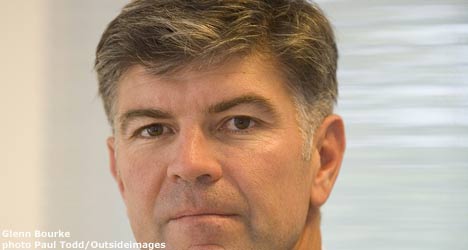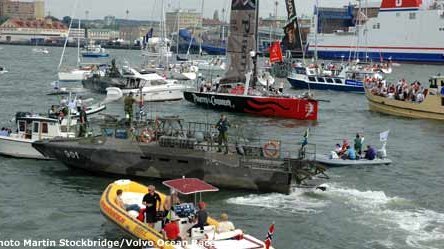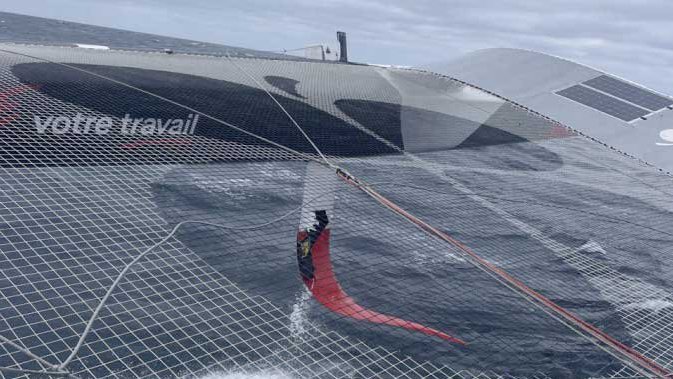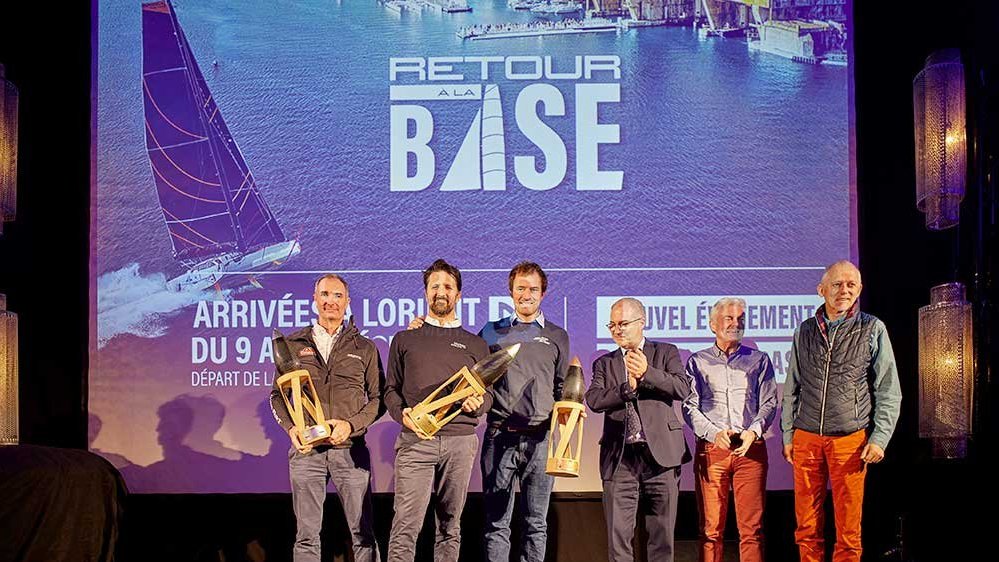
Volvo Ocean Race
Glenn Bourke about the format for the 2008-09 race
"Further change was required to make it more commercially enticing"
jeudi 28 septembre 2006 –

Q : How do you respond to recent criticism of the revised format for the 2008-09 race ?
A : The fact is, there needed to be change. The primary objective is to make sure the future of the race is secure, that it continues to grow and evolve as a competitive event and that more corporations look at it as a viable mechanism for an investment by them. We couldn’t say that under the old guise we had actually achieved that. We had gone some way towards it because of the changes we made to the 2005-06 format, but further change was required to make it more commercially enticing. The speed of the new boats has enabled us to bring about these changes. We can cover much more distance in the same amount of time as say the 2001-02 race. We can take in a diversity of territories, we can make it truly global.
Q : Can you clarify the situation on the southern ocean relative to the route ?
A : The route will start in Alicante, Spain in late 2008. The proposed route from there will be around the Cape of Good Hope to the Middle East. From the Middle East to the Sub Continent and on to South East Asia and then China. From China dipping down to Australia or New Zealand. That will provide a couple of long spells in southern ocean conditions. And let’s not forget that in the last race we decided not to send these boats careering through icebergs. So is there little difference from the north pacific to the southern ocean if you’re not going deep in through icebergs ?
And, as was proven, boats will break in the Bay of Biscay on their first night out at sea (in the 2005-06 race) in horrendous conditions. Or in the transatlantic crossing from New York when some of us thought the race was almost over. The hostile conditions the fleet experienced out there in the transatlantic were some of the worst the crews had ever encountered in ocean racing. So, it’s a myth to say that the southern ocean is more of a test than anywhere else. It’s simply not true.
Even the last race bears that out. Ask the sailors where they had their toughest moments of sailing and the answer may well be the Bay of Biscay and the transatlantic. The perception is that the southern ocean makes it a global race. Just the perception, because of the historical nature of it. But is it easier to sail around the equator in tricky tactical challenges where good performance over a wide range of wind conditions is important ? I don’t think so. We are not detracting from the race by altering the route – but we are enhancing it by taking it beyond its traditional footprint.
Q : What is the sailors’ view of the southern ocean – surely that’s what matters most ?
A : There are plenty of sailors who have been absolutely scared out of their wits in the southern ocean and said ‘I’m never going to do that again’. Spearing through icebergs at high speed carries an intangible risk. Under the old model there were plenty of people who didn’t enjoy going into the southern ocean. The debilitating cold, the injuries and illness – it might sound all brazen and heroic but it’s very different in reality. When we put ice gates in for 2005-06 hardly anybody complained about it after the legs were sailed. Prior to the start, one crew member complained to me that we weren’t going south enough. But when he finished the leg, he came back to me and said ‘I’m so glad we didn’t go through icebergs’.
Q : What has been the reaction to the new route and shape of the 2008-09 race from the likes of Mike Sanderson (the winning skipper in 2005-06) ?
A : The guys who have been out there at the coalface, the skippers and crew members, are fully supportive of the new route. Guys like Mike Sanderson, Paul Cayard and Mark Christensen. For those people you prescribe the route and the vehicle they have to drive around that route and they see it as a challenge. Similarly if you said to them ‘go sail in a one-design boat’ they’d be happy enough to do that and pit their skills against other people. Whatever the vehicle is for competition, they want to understand it, absorb it and go and use it. Neither Mike, Paul or Mark has said that the route is a problem. They believe it is an advantage to the race in general.
Q : In arriving at the format for the 2008-09, whose opinions have you sought ?
A : Consultation is one of our strong suits and people outside of our advisory groups might not fully understand that. We talk openly and often to as many people as possible to gauge the consensus. Just occasionally the consensus isn’t the final outcome, and it isn’t the driver. Sometimes you have to do things slightly differently. But as long as you have weighed up opinion, it will lead you to a sensible outcome. The template for that was set with the initial draft of the Rule for 2005-06 – as early as 2002. I was speaking to sailors and designers at the America’s Cup America's Cup #AmericasCup at the time every single day when we were assessing what the format should be. We then called a forum here in the UK where we invited all the designers and many of the skippers and navigators from the last race and we went through all of our thoughts and canvassed their opinions on the ideas we were coming up with. From that point on we had active communications with all of the designers on the detail of the Rule and they guided us to what this boat eventually became – the Volvo Open 70. In framing the Rule we had approval authorities, engineers, safety advisors and designers instructing us how the Rule should be created.
Q : Was that the philosophy you followed with the skippers and designers’ forum in Melbourne following the problems with keel mechanisms in the first two legs of the 2005-06 race ?
A : Yes, in Melbourne, we called everyone together to openly discuss the situation and thrash out a solution. The sailors told us, unequivocally, ‘do not meddle in what we are doing right now because we have a much clearer picture of what’s going on out there than you do and there is no inherent flaw in the rule, the inherent flaw is in how we’ve tried to get around the rule to give ourselves a performance advantage. So now let us go back to the drawing board and think about how we repatriate these boats to make them suitable for this kind of sailing at these speeds’. And they were adamant that the Rule did not prevent them from doing that. What we have done subsequently is to look at the Rule again and give them an incentive to build boats that are more robust.
Q : Did you ever feel at any time that the crews in the 2005-06 race were
put at unnecessary risk ?
![]() A : First of all, let’s never forget that these guys love what they’re doing. For that reason the boats are exciting, they are challenging and they see themselves as pioneers. Round the world sailors fully appreciate the risks involved when they sign up for this race or any offshore race. There were ill-informed calls for our crews to be removed from the southern ocean amid claims that the Volvo Open 70s were too radical. Mike Sanderson was adamant at the time that if anyone wanted him and his crew to leave the southern ocean then somebody would have to come down and forcibly remove them. Paul Cayard added : “As far as I can remember there aren’t a lot of points of land or holidays named after people who sat at home and criticised Christopher Columbus”. I think they said it all.
A : First of all, let’s never forget that these guys love what they’re doing. For that reason the boats are exciting, they are challenging and they see themselves as pioneers. Round the world sailors fully appreciate the risks involved when they sign up for this race or any offshore race. There were ill-informed calls for our crews to be removed from the southern ocean amid claims that the Volvo Open 70s were too radical. Mike Sanderson was adamant at the time that if anyone wanted him and his crew to leave the southern ocean then somebody would have to come down and forcibly remove them. Paul Cayard added : “As far as I can remember there aren’t a lot of points of land or holidays named after people who sat at home and criticised Christopher Columbus”. I think they said it all.
Q : How much influence does Volvo have in the overall decision-making
process ?
![]() A : Safety is one of Volvo’s core values. That’s a fact. However, Volvo fully understands and has always understood that global ocean racing sailing is a dangerous sport. They don’t fear that. They understand that is one of the elements which make it interesting and absorbing for the general public. And they do not want to water down those inherent character traits. It is up to us, as race organisers, to put in place as many safety measures as we possibly can – the best support network, through our duty officers, the Derriford Clinic medical facilities, our in-port racing management in collaboration with the local coast guard and police, and our advanced on-board communications systems. They have to be at the highest level possible in sailing then Volvo will be satisfied. You have to understand that when you design a boat which can reach up to 45 knots of boat speed, there are risks. Big risks. And sailing out there at those speeds is going to be a testing physical and psychological challenge. Volvo understands that and it is one of the key reasons they are so engaged with ocean racing sailing.
A : Safety is one of Volvo’s core values. That’s a fact. However, Volvo fully understands and has always understood that global ocean racing sailing is a dangerous sport. They don’t fear that. They understand that is one of the elements which make it interesting and absorbing for the general public. And they do not want to water down those inherent character traits. It is up to us, as race organisers, to put in place as many safety measures as we possibly can – the best support network, through our duty officers, the Derriford Clinic medical facilities, our in-port racing management in collaboration with the local coast guard and police, and our advanced on-board communications systems. They have to be at the highest level possible in sailing then Volvo will be satisfied. You have to understand that when you design a boat which can reach up to 45 knots of boat speed, there are risks. Big risks. And sailing out there at those speeds is going to be a testing physical and psychological challenge. Volvo understands that and it is one of the key reasons they are so engaged with ocean racing sailing.
Q : What do you say to the aficionados who claim that the 2008-09 race is putting commercialism before competition ?
![]() A : They go hand in hand. You can’t have competition unless it is commercially viable because you won’t have enough teams to make the overall competition meritorious. In sport these days the benefits that the sportsmen and women receive from a strong commercial base is exactly what they want. So they are not afraid of the race being more commercial. It creates more opportunities for them. Our intention is never to detract from the competitive element of the race with whatever innovations we introduce. At the end of the day, this is a yacht race and competition it at its core. Plotting a new route and seeking out new stopover ports does not harm the intense competition and test of human endeavour that this race represents.
A : They go hand in hand. You can’t have competition unless it is commercially viable because you won’t have enough teams to make the overall competition meritorious. In sport these days the benefits that the sportsmen and women receive from a strong commercial base is exactly what they want. So they are not afraid of the race being more commercial. It creates more opportunities for them. Our intention is never to detract from the competitive element of the race with whatever innovations we introduce. At the end of the day, this is a yacht race and competition it at its core. Plotting a new route and seeking out new stopover ports does not harm the intense competition and test of human endeavour that this race represents.
Q : Why has the four-year cycle of the race been broken ?
![]() A : Our end goal would be to make this event so strong that teams come back time and time again. In order for that to happen there needs to be greater continuity which encourages sponsors to return. So it could be the case that we would look to shorten the time frame further if it worked for everybody.
A : Our end goal would be to make this event so strong that teams come back time and time again. In order for that to happen there needs to be greater continuity which encourages sponsors to return. So it could be the case that we would look to shorten the time frame further if it worked for everybody.
Q : What personal experiences from 2005-06 will you most learn from for the future ?
![]() A : The biggest lesson is never to assume anything. Never assume that boats won’t break or that conditions will be benign because situations can change in an instant. Simple days can turn into days of havoc. Never be complacent. And, that all the preparatory steps you take and measures you put in place in terms of safety, operational and medical planning are absolutely fundamental to managing a crisis as effectively as possible.
A : The biggest lesson is never to assume anything. Never assume that boats won’t break or that conditions will be benign because situations can change in an instant. Simple days can turn into days of havoc. Never be complacent. And, that all the preparatory steps you take and measures you put in place in terms of safety, operational and medical planning are absolutely fundamental to managing a crisis as effectively as possible.
Q : What are the biggest challenges you are facing with the 2008-09 race ?
![]() A : The biggest test is in organising the new ports and getting the same level of professionalism, co-operation and service that we experienced from the past ports. The scheduling of the length of legs will present difficulties because the scope of arrival times will be bigger than before owing to the changeable conditions. We could have very long periods in port and very short periods in port and we will have to deal with them as they come.
A : The biggest test is in organising the new ports and getting the same level of professionalism, co-operation and service that we experienced from the past ports. The scheduling of the length of legs will present difficulties because the scope of arrival times will be bigger than before owing to the changeable conditions. We could have very long periods in port and very short periods in port and we will have to deal with them as they come.
Q : Will in-port racing remain as part of the format ?
![]() A : In-port racing was hugely successful. It gave us an opportunity to engage the local communities in each port, particularly the non-sailors. It gave us the chance to showcase sail boat racing at seriously high speeds at close quarters to non-traditional media, governmental and corporate figures in an experiential sense. It spawned a whole raft of stories of speed and exhilaration and it enhanced the enjoyment of the race for port spectators and television and web audiences worldwide.
A : In-port racing was hugely successful. It gave us an opportunity to engage the local communities in each port, particularly the non-sailors. It gave us the chance to showcase sail boat racing at seriously high speeds at close quarters to non-traditional media, governmental and corporate figures in an experiential sense. It spawned a whole raft of stories of speed and exhilaration and it enhanced the enjoyment of the race for port spectators and television and web audiences worldwide.
Q : At what stage are you with negotiations with proposed new ports in
Asia and the Middle East ?
![]() A : Alicante is well advanced with putting its team together in preparation for the start of the race. We have started talks with the Middle East and received positive responses. We have been out to India and are trying to identify the right venue for them to host a pit stop or a shorter stopover. We’ve been to Singapore which has huge support from government agencies and authorities such as the Singapore Sailing Federation and the Navy, and we are also making further trips to China where we were warmly received on our initial visit. In short, the enthusiasm has been infectious.
A : Alicante is well advanced with putting its team together in preparation for the start of the race. We have started talks with the Middle East and received positive responses. We have been out to India and are trying to identify the right venue for them to host a pit stop or a shorter stopover. We’ve been to Singapore which has huge support from government agencies and authorities such as the Singapore Sailing Federation and the Navy, and we are also making further trips to China where we were warmly received on our initial visit. In short, the enthusiasm has been infectious.
Q : Will you adopt a different approach to promoting and communicating the event ?
![]() A : We have analysed and continue to analyse every single aspect of the management and organisation
Organisation
#organisation
of the race. We have been open and frank in our assessments of what we did well, where we went wrong and where we can improve. We have handed out brickbats and bouquets in equal measure. Since television has the greatest impact on media return, it will come under close scrutiny as part of our continuing evaluation of the race. What we will look at most earnestly are the television distribution deals. Explore what time slots we can secure and how we might leverage syndicates, ports and sponsors in negotiating favourable time slots in targeted territories ? In terms of the programmes themselves, they were excellent so I believe we have the right model for that. Undoubtedly the most potent weapon in our armoury has been our ability to bring the drama of the race directly to the armchair viewer via video, stills, audio and e-mail despatches. Our job going forward is to continue to engage as wide an audience as possible for the benefit of the race and sailing as a whole.
A : We have analysed and continue to analyse every single aspect of the management and organisation
Organisation
#organisation
of the race. We have been open and frank in our assessments of what we did well, where we went wrong and where we can improve. We have handed out brickbats and bouquets in equal measure. Since television has the greatest impact on media return, it will come under close scrutiny as part of our continuing evaluation of the race. What we will look at most earnestly are the television distribution deals. Explore what time slots we can secure and how we might leverage syndicates, ports and sponsors in negotiating favourable time slots in targeted territories ? In terms of the programmes themselves, they were excellent so I believe we have the right model for that. Undoubtedly the most potent weapon in our armoury has been our ability to bring the drama of the race directly to the armchair viewer via video, stills, audio and e-mail despatches. Our job going forward is to continue to engage as wide an audience as possible for the benefit of the race and sailing as a whole.
Q : So evolution not revolution for 2008-09 ?
![]() A : Absolutely. Some people might say that what we are doing with the 2008-09 race is revolutionary but those same people said that about the innovations for the previous race. I don’t believe that is the case. Of the five new ideas we brought to the race – the Volvo Open 70, scoring gates, in-port racing, guests on board and the Volvo Extreme 40s – each one of those contributed in a significant way to making this race much better than before. We will keep all of those elements and expanding into fresh markets will excite a completely new audience for us.
A : Absolutely. Some people might say that what we are doing with the 2008-09 race is revolutionary but those same people said that about the innovations for the previous race. I don’t believe that is the case. Of the five new ideas we brought to the race – the Volvo Open 70, scoring gates, in-port racing, guests on board and the Volvo Extreme 40s – each one of those contributed in a significant way to making this race much better than before. We will keep all of those elements and expanding into fresh markets will excite a completely new audience for us.
Dans la même rubrique
Volvo Ocean Race : Global win for Mike Sanderson and his crew

Volvo Ocean Race : Paul Cayard pirates last leg from Seb Josse

Volvo Ocean Race : Sanderson wins Rotterdam inshore

Volvo Ocean Race : Torben Grael wins leg 8 in Rotterdam

 Sea, Sail & Surf news
Sea, Sail & Surf news










